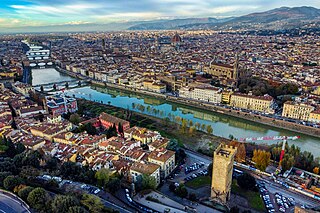
The Arno is a river in the Tuscany region of Italy. It is the most important river of central Italy after the Tiber.

Canals or artificial waterways are waterways or engineered channels built for drainage management or for conveyancing water transport vehicles. They carry free, calm surface flow under atmospheric pressure, and can be thought of as artificial rivers.
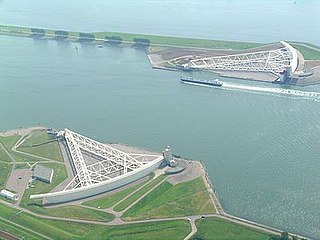
The Nieuwe Waterweg is a ship canal in the Netherlands from het Scheur west of the town of Maassluis to the North Sea at Hook of Holland: the Maasmond, where the Nieuwe Waterweg connects to the Maasgeul. It is the artificial mouth of the river Rhine.

Pisa is a city and comune (municipality) in Tuscany, central Italy, straddling the Arno just before it empties into the Ligurian Sea. It is the capital city of the Province of Pisa. Although Pisa is known worldwide for its leaning tower, the city contains more than twenty other historic churches, several medieval palaces, and bridges across the Arno. Much of the city's architecture was financed from its history as one of the Italian maritime republics.

Livorno is a port city on the Ligurian Sea on the western coast of the Tuscany region, Italy. It is the capital of the Province of Livorno, having a population of 158,493 residents in December 2017. It is traditionally known in English as Leghorn.

The Chesapeake & Delaware Canal is a 14-mile (22.5 km)-long, 450-foot (137.2 m)-wide and 35-foot (10.7 m)-deep ship canal that connects the Delaware River with the Chesapeake Bay in the states of Delaware and Maryland in the United States.
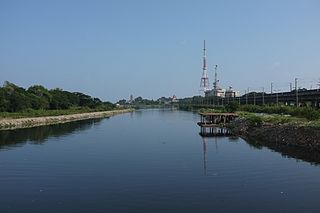
The Cooum River, or simply Koovam, is one of the shortest classified rivers draining into the Bay of Bengal. This river is about 72 km (45 mi) in length, flowing 32 km (20 mi) in the city of Chennai and the rest in rural part. The river is highly polluted in the urban area (Chennai). Along with the Adyar River running parallel to the south and the Kosasthalaiyar River, the river trifurcates the city of Chennai and separates Northern Chennai from Central Chennai. It is also sometimes known as Thiruvallikenni river

The Ciliwung is a 119 km long river in the northwestern region of Java where it flows through two provinces, West Java and the special region of Jakarta. The natural estuary of the Ciliwung, known as the Kali Besar, was an important strategic point for trade in the precolonial and colonial periods and was instrumental in the founding of the port city of Jakarta, but has been lost from a reorganization of the watercourse of the rivers around the area into canals.
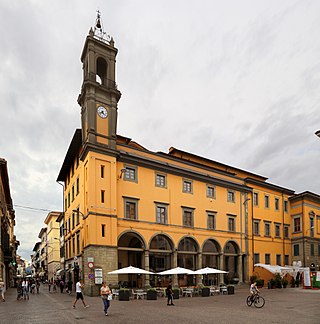
Pontedera is an Italian comune with a population of 30070, located in the province of Pisa, Tuscany, central Italy.

Marina di Pisa is a seaside resort of Tuscany, in central Italy. It is a frazione of the provincial capital of Pisa, which lies about 10 km to the east.

Gorgona is the northernmost island in the Tuscan Archipelago, a group of islands off the west coast of Italy. Between Corsica and Livorno, this diminutive island has been valued most for its wildlife, especially marine birds, and its isolation. The latter quality resulted in the foundation of Gorgona Abbey in the Middle Ages. After its closure the monastery grounds and buildings were appropriated in 1869, at the foundation of an agricultural penal colony, which is currently in use.

The New River is a tidal estuary in South Florida, United States. Despite its name, it is not a true natural river, but a channel composed of many tributary canals. The channel is connected to the Everglades through a series of man-made canals. After passing through Fort Lauderdale, the channel connects to the Intracoastal Waterway and Atlantic Ocean at Port Everglades cut. The channel is entirely within Broward County and is composed from the junction of three main canals which originate in the Everglades, splitting off from the Miami Canal. They are the North New River Canal, which flows south from Lake Okeechobee along the east side of U.S. 27 and then east along the north side of State Road 84 / Interstate 595; the South New River Canal, which flows east from the Miami Canal along the north side of Griffin Road and the south side of Orange Drive; and a canal which flows east along the south side of Sunrise Boulevard. The Henry E. Kinney Tunnel in downtown Fort Lauderdale travels underneath the New River.
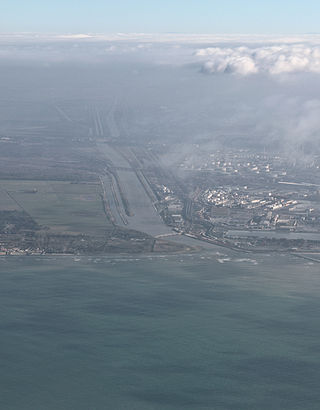
Lo Scolmatore dell'Arno is a 28 kilometers (17 mi) artificial flood control channel of the river Arno from Pontedera to the Ligurian Sea at Calambrone. As a consequence of the Arno flood of 1949, it was decided to start the construction of Scolmatore dell'Arno in 1954 at a cost of more than 10 billion lire of the time. The work was not completed in time for the disastrous flood of 1966 that, in addition to Florence, caused enormous damages in Pontedera and Pisa.
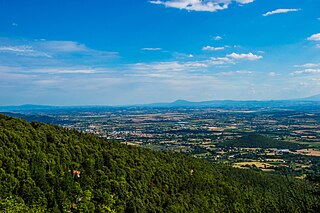
The Val di Chiana, Valdichiana, or Chiana Valley, formerly Clanis Valley, is a tectonic valley of central Italy, whose valley floor consists of important alluvial residues filled up since the 11th century, lying on the territories of the provinces of Arezzo and Siena in Tuscany and the provinces of Perugia and Terni in Umbria.

The Port of Livorno is one of the largest Italian seaports and one of the largest seaports in the Mediterranean Sea, with an annual traffic capacity of around 30 million tonnes of cargo and 700,000 TEU's.

The Tay Canal is the portion of the Tay River in the eastern Ontario region, providing a connection between the town of Perth and the Rideau Canal at Beveridge Bay on Lower Rideau Lake. The canal is 9.8 km in length and is operated today by Parks Canada as part of their Rideau Canal operations. At the entrance to the Tay Canal are two locks, Upper and Lower Beveridge Locks, which provide a total lift of 7.6 m (25 ft).

The Pisa–Florence railway is a line built in the 1840s connecting the Tuscan cities of Florence, Pisa and Livorno, passing through Empoli and Pontedera. It is 101 km long and fully electrified at 3,000 V DC. Passenger traffic is managed by Trenitalia.

The Pisa–Lucca railway is a line that was built in 1846 connecting the Tuscan cities of Pisa and Lucca. It is fully electrified at 3,000 V DC. Passenger traffic is managed by Trenitalia.
Porto Pisano, also known as Triturrita, was the main seaport of the Republic of Pisa, located on the Ligurian Sea coast close to the mouth of the Arno River. In the 13th century, at its peak, Porto Pisano was one of the most important sea ports in Italy, which rivaled if not surpassed both Genoa and Venice.
The following is a timeline of the history of the city of Livorno in the Tuscany region of Italy.




















